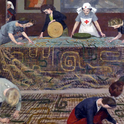Our thinking about technology is deficient. We are over- impressed by apparent novelty, by speed, noise and general whizziness. We need a more grown-up way of thinking about the past, present and future of technology.
The term "technology" has in recent decades become closely associated with invention, innovation, creativity and the future. Today it sometimes seems to mean little more than novelties in information technology. Students of technology have a narrow focus: they study research and development, patents and the early stages of technical developments. But to understand technology in society, one needs to study technologies that are in wide use and are not necessarily so whizzy or so new.
Invention-centred timelines are entrenched in our understanding of technology and history. The technology of 1900 is taken to be the motor car, electricity and synthetic chemicals; that of 1950, rockets, nuclear weapons and power, and computers; that of 2000, biotechnology, information technology and nanotechnology. These are the bread and butter of historical texts, museum displays, television documentaries and many of the long-wave theories of economic development. We all seem to have absorbed the same account of the trajectory of modernity. What we have is an account that is highly biased towards the early stages of very few technologies.
We can illustrate the point with some counter-examples. The number of horses in US agriculture, by far the most mechanised in the world in the early 20th century, didn't peak until 1915. Even in the second world war the horse was crucial at least to some combatants. The Wehrmacht marched on the Soviet Union with more horses than Napoleon; it even had more horses per soldier. The horse was more important than the V2 rocket to the Nazis; indeed the V2 was economically and militarily irrational, killing more people working for the Germans than for the Allies. After 1945, one of the greatest unheralded changes was the massive rise in the land and labour productivity of agriculture, which was much faster than that of industry. This was down to many factors, among them synthetic nitrate, irrigation, new crop varieties and tractors, all techniques that were at best decades old. Chemistry is missing from our history of the 20th century, despite the importance of fertilisers and all sorts of new materials, from plastics to herbicides.
Remarkably, that great pre-industrial fuel and construction material, wood, has become ever more important. Paper consumption increases, for all the talk of paperless offices. Packaging booms: think of all those Amazon books in cardboard covers arriving by post. And consider the case of Ikea. Ingvar Kamprad, its founder, is on some estimates richer than Bill Gates. He makes money from designing and selling wood furniture using Fordist mass production techniques. His biggest-selling product is not a computer desk, but the "Billy" bookcase. Ikea subverts the modern and postmodern notions of what we are in another way—it has shifted part of the production and transportation of furniture away from specialist employees back to the household. He has created a new urban peasantry, who have to load, transport and build furniture.
Wood is at the centre of one of the first eco-economic wars. A few miles north of the town of Fray Bentos, Uruguay, on the river Uruguay, the Finnish firm Botnia is building a wood-pulp mill. The factory will process timber from Uruguay's new plantations. The visual and chemical pollution that will allegedly result has caused Argentinean environmentalists to obstruct two of the international bridges that cross the river between Argentina and Uruguay and to threaten the third crossing, at Salto, as well as ferry services from Buenos Aires. This is a major regional dispute resulting in great damage to the Uruguayan economy.
The new is often older than we think. A few years ago, Naomi Klein's No Logo was all the rage in anti-globalisation circles, and indeed beyond. Klein's argument was that we are moving into a radically novel world in which money is made in marketing and design (the logo), while production is put out to the global poor working in wretched conditions. Yet one can find much earlier examples. In 1865, a brilliantly marketed new biotechnological product appeared in Europe. Liebig's extract of meat was named after the greatest chemist of the mid-19th century, Justus von Liebig, a professor in Munich until his death in 1873. Liebig had improved a process for turning meat into a concentrated extract (of negligible nutritive value), and lent his prestige to the Anglo-Belgian enterprise—the Liebig Extract of Meat Company (Lemco). Liebig's name, and signature, became a powerful brand. The company produced illustrated advertising cards that figure in the history of advertising, and the rarer ones change hands for thousands of pounds in antique shops today. A version of the meat extract was renamed Oxo in the 1890s for the British market, a brand that is important to this day. It was produced by the Liebig company in Fray Bentos, hence the trade name for the company's corned beef and meat pies.
While Britain killed its own cattle in comparatively tiny slaughterhouses, as it would do for very many decades to come, the Fray Bentos plant was perhaps briefly the largest single slaughterhouse in the world. It dispatched over 200,000 cattle a year and employed over a thousand workers at busy times. This scale of operation was all the more remarkable because Liebig was not freezing or chilling meat—the business of some of the great Chicago meatpackers, like Swift or Armour. These meatpackers would themselves come to Uruguay and Argentina to supply meat mainly to Britain, easily the largest importer of meat in the world. Nearly half of Britain's meat came from the other side of the equator. Globalisation made possible by technology is hardly new. In this case, beef, and its processing, made Uruguay rich. (With moderate good fortune, a southern Spaniard or Italian would have multiplied their income many times over by moving to the River Plate in the first half of the 20th century; today the reverse would be true.)
The Fray Bentos factory was extended and rebuilt. Then the whole complex was taken over in 1924 by the Vestey family, the only real rivals to the American meatpackers. The Vesteys ran it until the 1960s, with hardly any new investment. Nationalisation kept it going until 1979. Long use ensured its preservation, and today the plant is one of the most extraordinary industrial monuments in the world. Part of the plant is now a museum known as the Museum of the Industrial Revolution. It is a good title, for the plant is perhaps the only memorial to vitally important and long-lasting technologies of the late 19th and early 20th centuries. For anyone interested in industrial and technological history, the history of killing, globalisation, food preservation, refrigeration, and the modern office, it is a must-see. Nothing like it is left in Chicago.
Yet this is a museum of technology where none of these 20th-century technologies were invented. Neither Liebig's extract, nor the refrigeration equipment, nor the motor car, nor the Hereford cattle were originally made by locals. By the standard definitions of what is significant in the history of technology, Uruguay does not exist, yet as an intensive user of imported technologies, it was far more important than much of the northern hemisphere.
The special conditions of Uruguay make visible what is common to the whole world, including the richest parts. Wherever you go, most technology is imported. Even in Britain or Japan, invention is highly concentrated and specialised, and no more the common property of Britons or Japanese than it is of Uruguayans. Most technology in both countries has origins abroad too. In Britain, as in Uruguay, a great deal of old stuff is still in use, from Victorian sewers and railways to a high proportion of the houses we live in.
Consider the Falklands war. It is perhaps not so surprising that Argentina had a cruiser built in the US in the 1930s (the ill-fated Belgrano) and an aircraft carrier built in Britain in 1945; what is less well appreciated is that Britain bombed Port Stanley airport with aircraft designed in the 1940s, and sunk the Belgrano with torpedoes designed in the 1920s. That is not a sign of backwardness—the US bombed Vietnam, Iraq, Afghanistan and Iraq again with B-52 bombers designed and built in the 1950s.
These examples come from slow-growing rich countries. But far from being stuck in the past, poor countries have seen rapid transformation in the 20th century, whether in terms of population growth or politics. New kinds of technologies of poverty emerged in the 20th century that did not replicate the older technologies of rich countries. Thus Bogotá is not a version of early 20th-century London, nor is Lagos of Bucharest. Bogotá and Lagos are themselves nothing like what they were in 1900. They are new places. And these new cities are made of industrial materials: recycled machine-cut wood, cement, asbestos-cement, breeze blocks and corrugated iron. The last is perhaps the great material of the poor world, one whose reach is extending, including into very poor rural areas. Whole cities of tens of millions are now roofed with corrugated iron, just one example of a rapidly expanding old industry.
In a world in which, according to the new economy gurus, the digerati will rule a dematerialised and weightless economy, the seemingly old stuff grows everywhere. Global steel production is growing at 6 per cent, the same sort of rate as in the post-second world war boom. World trade in manufactures is booming, carried in vast container ships rather than on the information superhighway. The world's shipping fleet continues to expand, and ports have become big news, along with the price of copper, oil and soybeans.
The cases above, and many others, suggest that we need, at the least, a new sense of technological time. Instead of the standard timelines of modernity measured out in particular inventions, we need a sense of inventions and technologies in which old and new merge in complex ways. Most arguments about innovation today tell us that we are living in a radically new world that can learn nothing from the past. What we should learn from the past is how old this argument is, and how wrong it has nearly always been.
To visit the Fray Bentos factory, see www.anglo.8m.com or contact Rene Boretto on rboretto@adinet.com.uy













